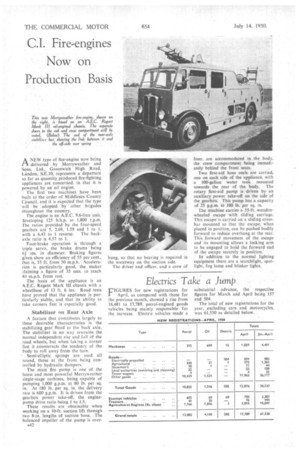C.1. Fire-engines Now on Production Basis
Page 52

If you've noticed an error in this article please click here to report it so we can fix it.
ANEW type of fire-engine now being delivered by Merryweather and Sons, Ltd., Greenwich High Road, London, S.E.I0, represents a departure so far as quantity produced fire-fighting appliances are concerned, in that it is powered .by an oil engine.
The first two machines have been built to the order of Middlesex County Council, and it is expected that the type will . be adopted by other brigades throughout the country.
The engine is an A.E.C. 9.6-litre unit, developing 125 b.h.p. at 1,800 r.p.m. The ratios provided by the four-speed gearbox are 5, 2.69, 1.59 and 1 to 1,
with a 6.43 to 1 reverse. The backaxle ratio is 4.57 to 1.
Foot-brake operation is through a triple servo, the brake drums being 61 ins, in diameter. Braking figures given show an efficiency of 55 per cent., that is, 55 ft. from 30 m.p.h. Acceleration is particularly good, the maker claiming a figure of 35 secs. to reach 40 m.p.h. from rest.
The basis of the appliance is an A.E.C. Regent Mark 111 chassis with a wheelbase of 13 ft. 6 ins. Road tests have proved that the appliance is particularly stable, and that its ability to take corners fast is especially good.
Stabilizer on Rear Axle
A feature that contributes largely to these desirable characteristics is the stabilizing gear fitted to the back axle. The stabilizer in no way restrains the normal independent rise and fall of the road wheels, but when taking a corner fast it counteracts the tendency of the body to roll away from the turn.
Semi-elliptic springs are used all round, those at the front being controlled by hydraulic dampers.
The main fire pump is one of the latest and most powerful Merryweather single-stage turbines, being capable of pumping 1,000 g.p.m. at 80 lb. per sq. in. At 180 lb. per sq. in. the delivery rate is 600 g.p.m. It is driven from the gearbox power take-off, the enginepump drive ratio being 1 to 1.5.
These results are obtainable when working on a 10-ft. suction lift through two 8-in, lengths of suction hose. The balanced impeller of the pump is over A42• hung, so that no bearing is required in the waterway on the suction side.
The driver and officer, and a crew of four, are accommodated in the body, the crew compartment being immediately behind the from seats.
Two first-aid hose reels are carried, one on each side of the appliance, with a 100-gallon water tank mounted towards the rear of the body. The rotary first-aid pump is driven by an auxiliary power take-off on the side of the gearbox. This pump has a capacity of 25 g.p.m. at 100 lb. per sq. in.
The machine carries a 55-ft. woodenwheeled escape with sliding carriage. This escape is carried on a sliding crossbar mounted so that the escape, when placed in position, can be pushed bodily forward to reduce overhang at the rear. This forward movement of the escape and its mounting allows a locking arm to be engaged to hold the forward end of the escape securely in position.
In addition to the normal lighting equipment there are a searchlight, spotlight, fog lamp and blinker lights.












































































